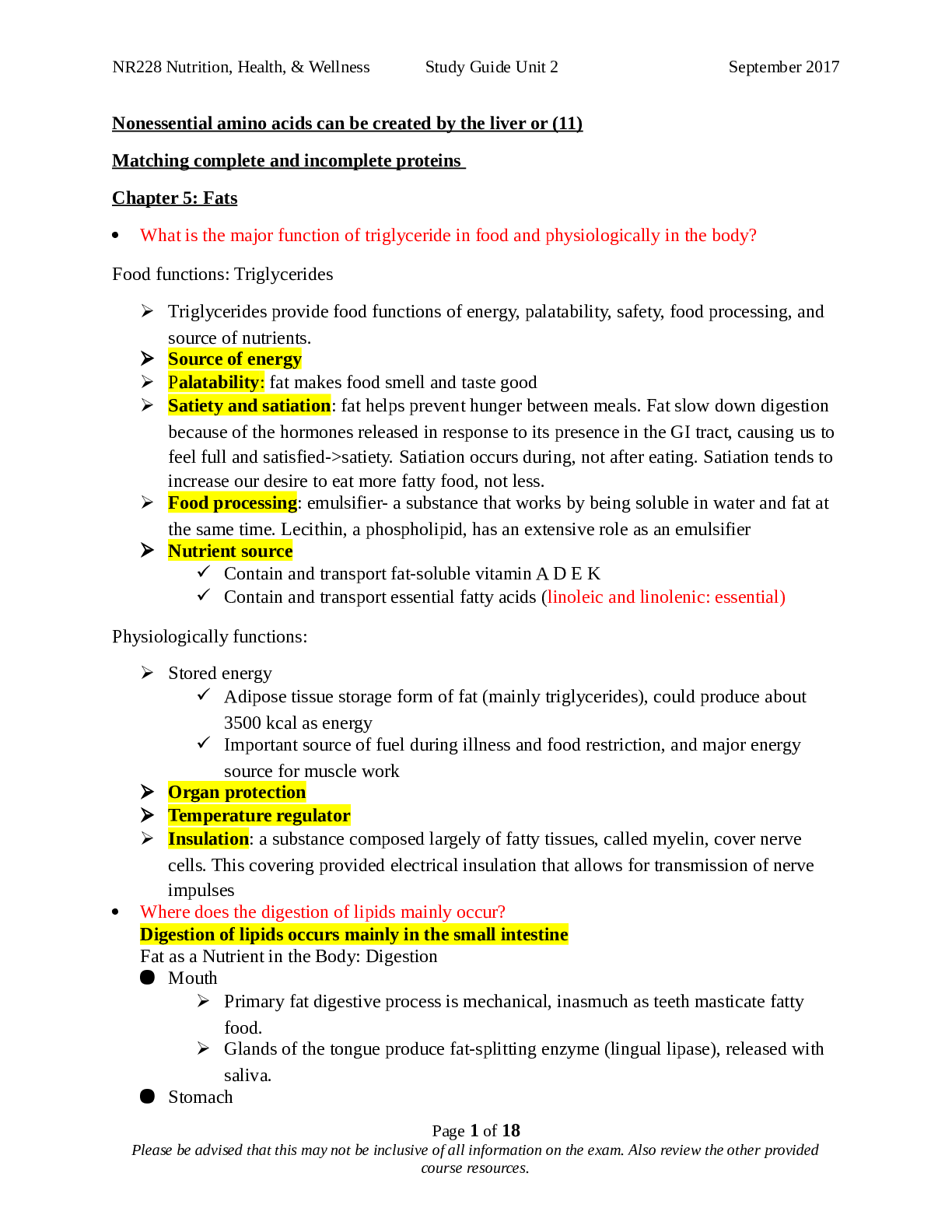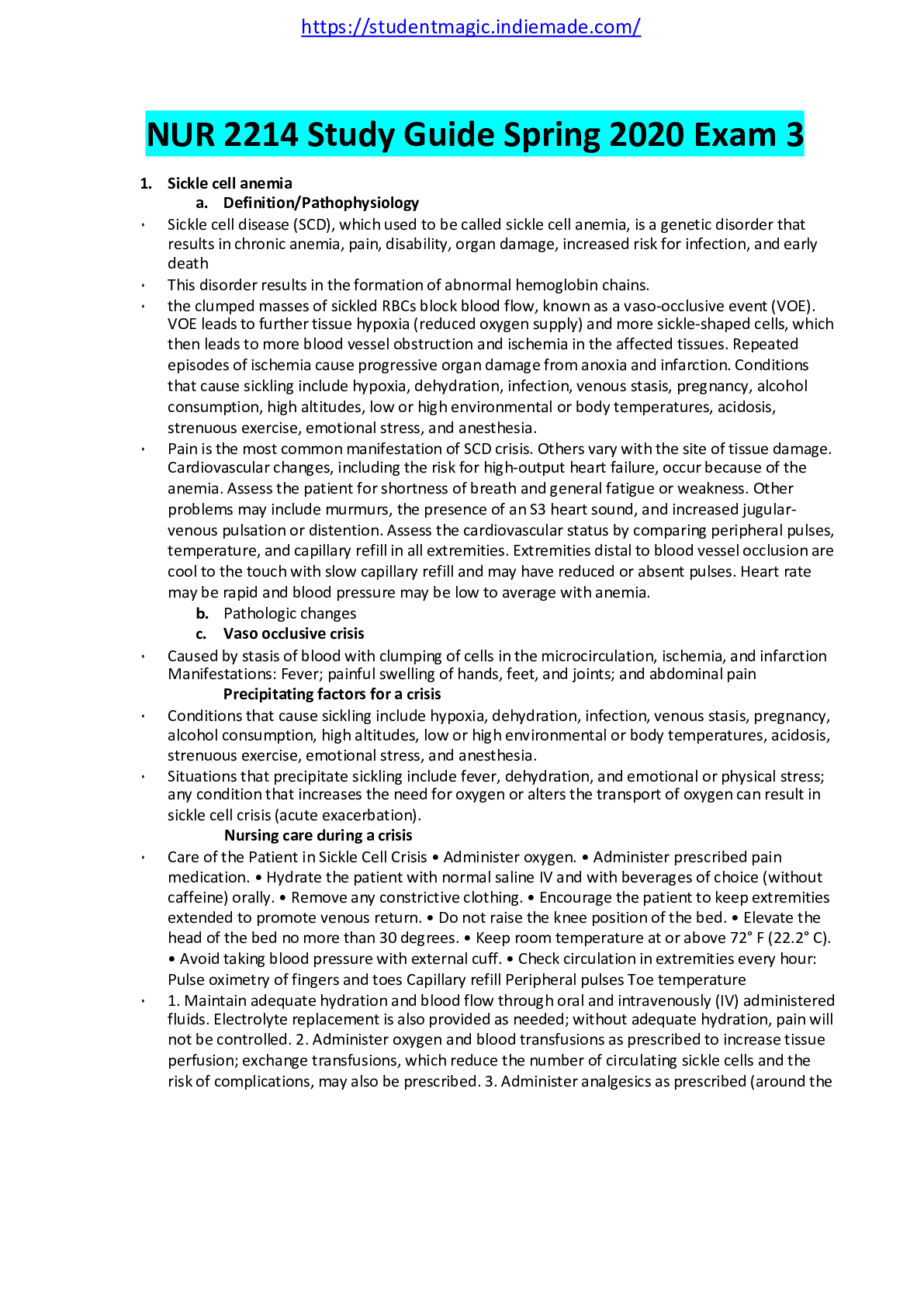*NURSING > STUDY GUIDE > CARE OF CLIENTS WITH PHYSIOLOGIC AND PSYCHOSOCIAL ALTERATIONS (All)
CARE OF CLIENTS WITH PHYSIOLOGIC AND PSYCHOSOCIAL ALTERATIONS
Document Content and Description Below
1. Nurse Michelle should know that the drainage is normal 4 days after a sigmoid colostomy when the stool is: Green liquid Solid formed Loose, bloody Semiformed 2. Where would nurse Kristine place t... he call light for a male client with a right-sided brain attack and left homonymous hemianopsia? On the client’s right side On the client’s left side Directly in front of the client Where the client like 3. A male client is admitted to the emergency department following an accident. What are the first nursing actions of the nurse? Check respiration, circulation, neurological response. Align the spine, check pupils, and check for hemorrhage. Check respirations, stabilize spine, and check circulation. Assess level of consciousness and circulation. 4. In evaluating the effect of nitroglycerin, Nurse Arthur should know that it reduces preload and relieves angina by: Increasing contractility and slowing heart rate. Increasing AV conduction and heart rate. Decreasing contractility and oxygen consumption. Decreasing venous return through vasodilation. 5. Nurse Patricia finds a female client who is post-myocardial infarction (MI) slumped on the side rails of the bed and unresponsive to shaking or shouting. Which is the nurse next action? Call for help and note the time. Clear the airway Give two sharp thumps to the precordium, and check the pulse. Administer two quick blows. 6. Nurse Monett is caring for a client recovering from gastro- intestinal bleeding. The nurse should: Plan care so the client can receive 8 hours of uninterrupted sleep each night. Monitor vital signs every 2 hours. Make sure that the client takes food and medications at prescribed intervals. Provide milk every 2 to 3 hours. 7. A male client was on warfarin (Coumadin) before admission, and has been receiving heparin I.V. for 2 days. The partial thromboplastin time (PTT) is 68 seconds. What should Nurse Carla do? Stop the I.V. infusion of heparin and notify the physician. Continue treatment as ordered. Expect the warfarin to increase the PTT. Increase the dosage, because the level is lower than normal. 8. A client undergone ileostomy, when should the drainage appliance be applied to the stoma? 24 hours later, when edema has subsided. In the operating room. After the ileostomy begin to function. When the client is able to begin self-care procedures. 9. A client undergone spinal anesthetic, it will be important that the nurse immediately position the client in: On the side, to prevent obstruction of airway by tongue. Flat on back. On the back, with knees flexed 15 degrees. Flat on the stomach, with the head turned to the side. 10.While monitoring a male client several hours after a motor vehicle accident, which assessment data suggest increasing intracranial pressure? Blood pressure is decreased from 160/90 to 110/70. Pulse is increased from 87 to 95, with an occasional skipped beat. The client is oriented when aroused from sleep, and goes back to sleep immediately. The client refuses dinner because of anorexia. 11. Mrs. Cruz, 80 years old is diagnosed with pneumonia. Which of the following symptoms may appear first? Altered mental status and dehydration Fever and chills Hemoptysis and Dyspnea Pleuritic chest pain and cough 12. A male client has active tuberculosis (TB). Which of the following symptoms will be exhibit? Chest and lower back pain Chills, fever, night sweats, and hemoptysis Fever of more than 104°F (40°C) and nausea Headache and photophobia 13. Mark, a 7-year-old client is brought to the emergency department. He’s tachypneic and afebrile and has a respiratory rate of 36 breaths/minute and has a nonproductive cough. He recently had a cold. Form this history; the client may have which of the following conditions? Acute asthma Bronchial pneumonia Chronic obstructive pulmonary disease (COPD) Emphysema 14. Marichu was given morphine sulfate for pain. She is sleeping and her respiratory rate is 4 breaths/minute. If action isn’t taken quickly, she might have which of the following reactions? Asthma attack Respiratory arrest Seizure Wake up on his own 15. A 77-year-old male client is admitted for elective knee surgery. Physical examination reveals shallow respirations but no sign of respiratory distress. Which of the following is a normal physiologic change related to aging? Increased elastic recoil of the lungs Increased number of functional capillaries in the alveoli Decreased residual volume Decreased vital capacity 16. Nurse John is caring for a male client receiving lidocaine I.V. Which factor is the most relevant to administration of this medication? Decrease in arterial oxygen saturation (SaO2) when measured with a pulse oximeter. Increase in systemic blood pressure. Presence of premature ventricular contractions (PVCs) on a cardiac monitor. Increase in intracranial pressure (ICP). 17. Nurse Ron is caring for a male client taking an anticoagulant. The nurse should teach the client to: Report incidents of diarrhea. Avoid foods high in vitamin K Use a straight razor when shaving. Take aspirin to pain relief. 18. Nurse Lhynnette is preparing a site for the insertion of an I.V. catheter. The nurse should treat excess hair at the site by: Leaving the hair intact Shaving the area Clipping the hair in the area Removing the hair with a depilatory. 19. Nurse Michelle is caring for an elderly female with osteoporosis. When teaching the client, the nurse should include information about which major complication: Bone fracture Loss of estrogen Negative calcium balance Dowager’s hump 20. Nurse Len is teaching a group of women to perform BSE. The nurse should explain that the purpose of performing the examination is to discover: Cancerous lumps Areas of thickness or fullness Changes from previous examinations. Fibrocystic masses 21. When caring for a female client who is being treated for hyperthyroidism, it is important to: Provide extra blankets and clothing to keep the client warm. Monitor the client for signs of restlessness, sweating, and excessive weight loss during thyroid replacement therapy. Balance the client’s periods of activity and rest. Encourage the client to be active to prevent constipation. 22. Nurse Kris is teaching a client with history of atherosclerosis. To decrease the risk of atherosclerosis, the nurse should encourage the client to: Avoid focusing on his weight. Increase his activity level. Follow a regular diet. Continue leading a high-stress lifestyle. 23. Nurse Greta is working on a surgical floor. Nurse Greta must logroll a client following a: Laminectomy Thoracotomy Hemorrhoidectomy Cystectomy. 24. A 55-year old client underwent cataract removal with intraocular lens implant. Nurse Oliver is giving the client discharge instructions. These instructions should include which of the following? Avoid lifting objects weighing more than 5 lb (2.25 kg). Lie on your abdomen when in bed Keep rooms brightly lit. Avoiding straining during bowel movement or bending at the waist. 25. George should be taught about testicular examinations during: when sexual activity starts After age 69 After age 40 Before age 20. 26. A male client undergone a colon resection. While turning him, wound dehiscence with evisceration occurs. Nurse Trish first response is to: Call the physician Place a saline-soaked sterile dressing on the wound. Take a blood pressure and pulse. Pull the dehiscence closed. 27. Nurse Audrey is caring for a client who has suffered a severe cerebrovascular accident. During routine assessment, the nurse notices Cheyne- Strokes respirations. Cheyne-strokes respirations are: A progressively deeper breaths followed by shallower breaths with apneic periods. Rapid, deep breathing with abrupt pauses between each breath. Rapid, deep breathing and irregular breathing without pauses. Shallow breathing with an increased respiratory rate. 28. Nurse Bea is assessing a male client with heart failure. The breath sounds commonly auscultated in clients with heart failure are: Tracheal Fine crackles Coarse crackles Friction rubs 29. The nurse is caring for Kenneth experiencing an acute asthma attack. The client stops wheezing and breath sounds aren’t audible. The reason for this change is that: The attack is over. The airways are so swollen that no air cannot get through. The swelling has decreased. Crackles have replaced wheezes. 30. Mike with epilepsy is having a seizure. During the active seizure phase, the nurse should: Place the client on his back remove dangerous objects, and insert a bite block. Place the client on his side, remove dangerous objects, and insert a bite block. Place the client o his back, remove dangerous objects, and hold down his arms. Place the client on his side, remove dangerous objects, and protect his head. 31. After insertion of a cheat tube for a pneumothorax, a client becomes hypotensive with neck vein distention, tracheal shift, absent breath sounds, and diaphoresis. Nurse Amanda suspects a tension pneumothorax has occurred. What cause of tension pneumothorax should the nurse check for? Infection of the lung. Kinked or obstructed chest tube Excessive water in the water-seal chamber Excessive chest tube drainage 32. Nurse Maureen is talking to a male client, the client begins choking on his lunch. He’s coughing forcefully. The nurse should: Stand him up and perform the abdominal thrust maneuver from behind. Lay him down, straddle him, and perform the abdominal thrust maneuver. Leave him to get assistance Stay with him but not intervene at this time. 33. Nurse Ron is taking a health history of an 84 year old client. Which information will be most useful to the nurse for planning care? General health for the last 10 years. Current health promotion activities. Family history of diseases. Marital status. 34. When performing oral care on a comatose client, Nurse Krina should: Apply lemon glycerin to the client’s lips at least every 2 hours. Brush the teeth with client lying supine. Place the client in a side lying position, with the head of the bed lowered. Clean the client’s mouth with hydrogen peroxide. 35. A 77-year-old male client is admitted with a diagnosis of dehydration and change in mental status. He’s being hydrated with L.V. fluids. When the nurse takes his vital signs, she notes he has a fever of 103°F (39.4°C) a cough producing yellow sputum and pleuritic chest pain. The nurse suspects this client may have which of the following conditions? Adult respiratory distress syndrome (ARDS) Myocardial infarction (MI) Pneumonia Tuberculosis CONTINUED...DOWNLOAD FOR BEST SCORES [Show More]
Last updated: 1 year ago
Preview 1 out of 46 pages
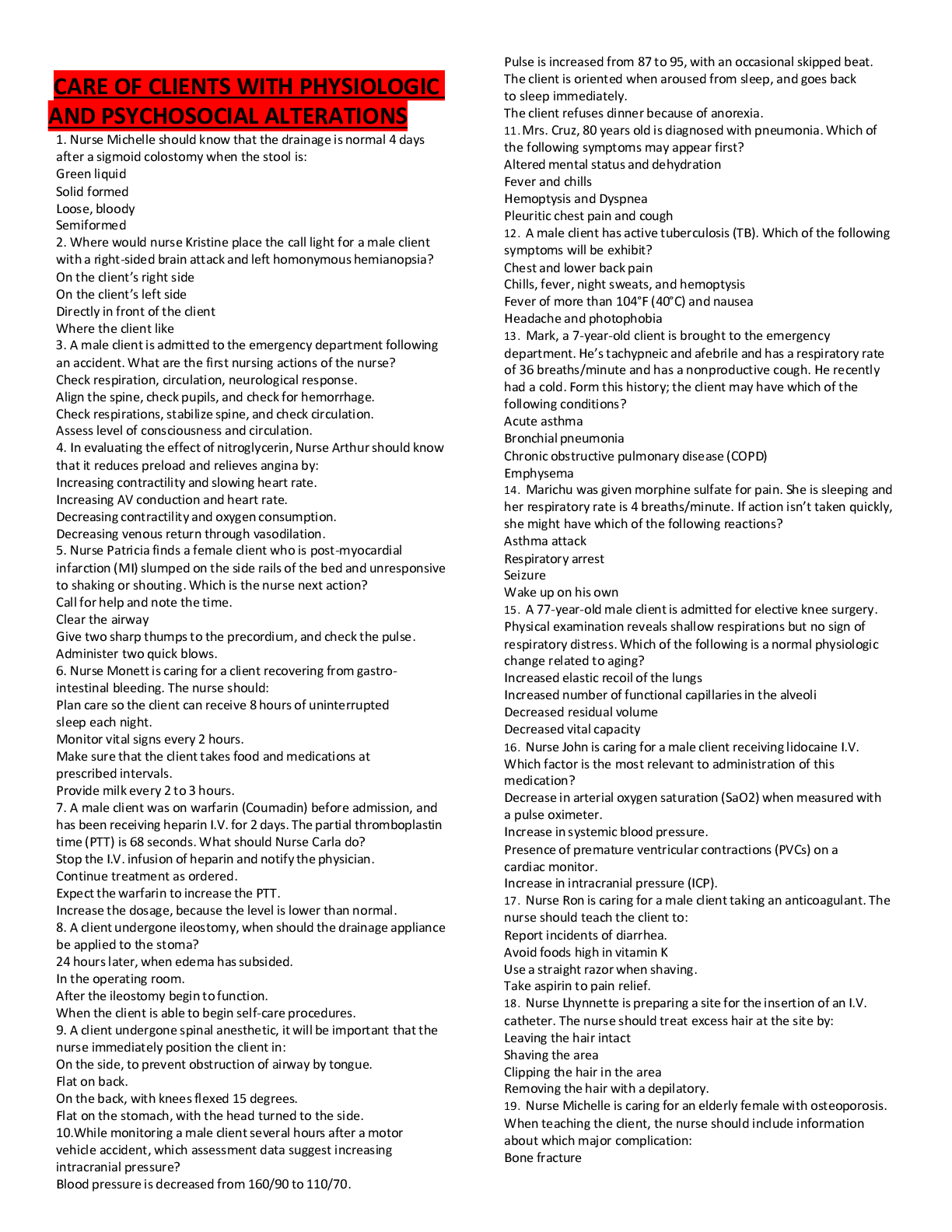
Reviews( 0 )
Document information
Connected school, study & course
About the document
Uploaded On
Jun 11, 2022
Number of pages
46
Written in
Additional information
This document has been written for:
Uploaded
Jun 11, 2022
Downloads
0
Views
47

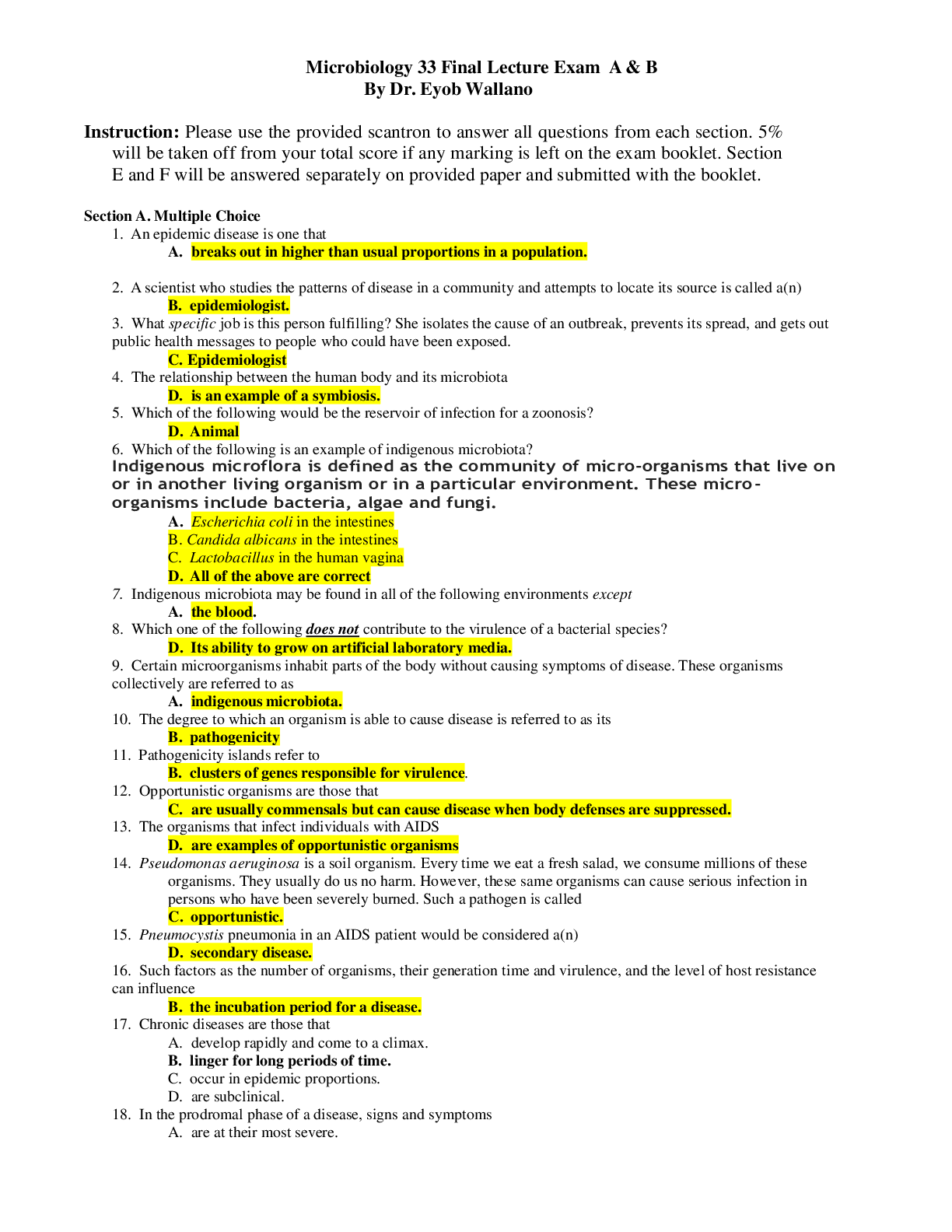
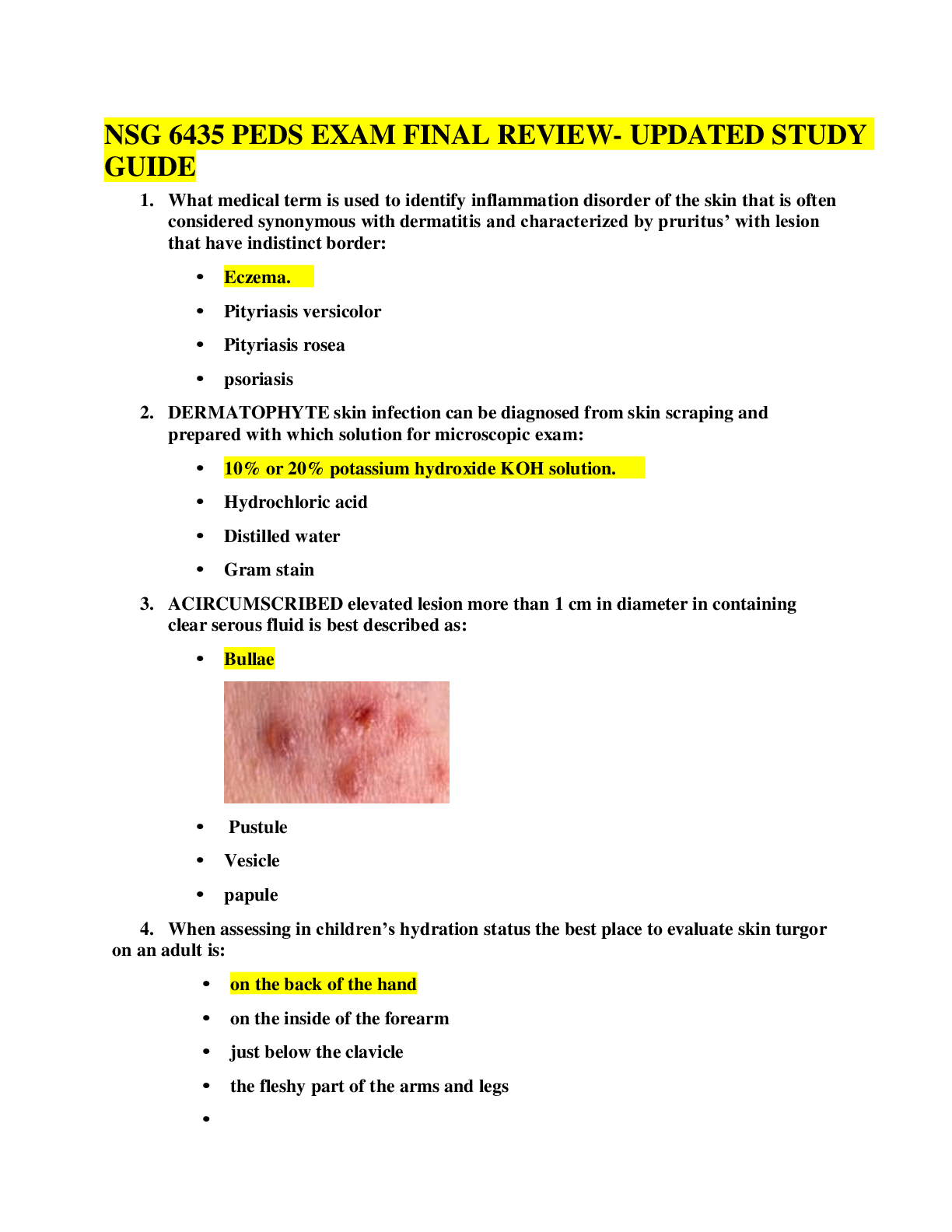







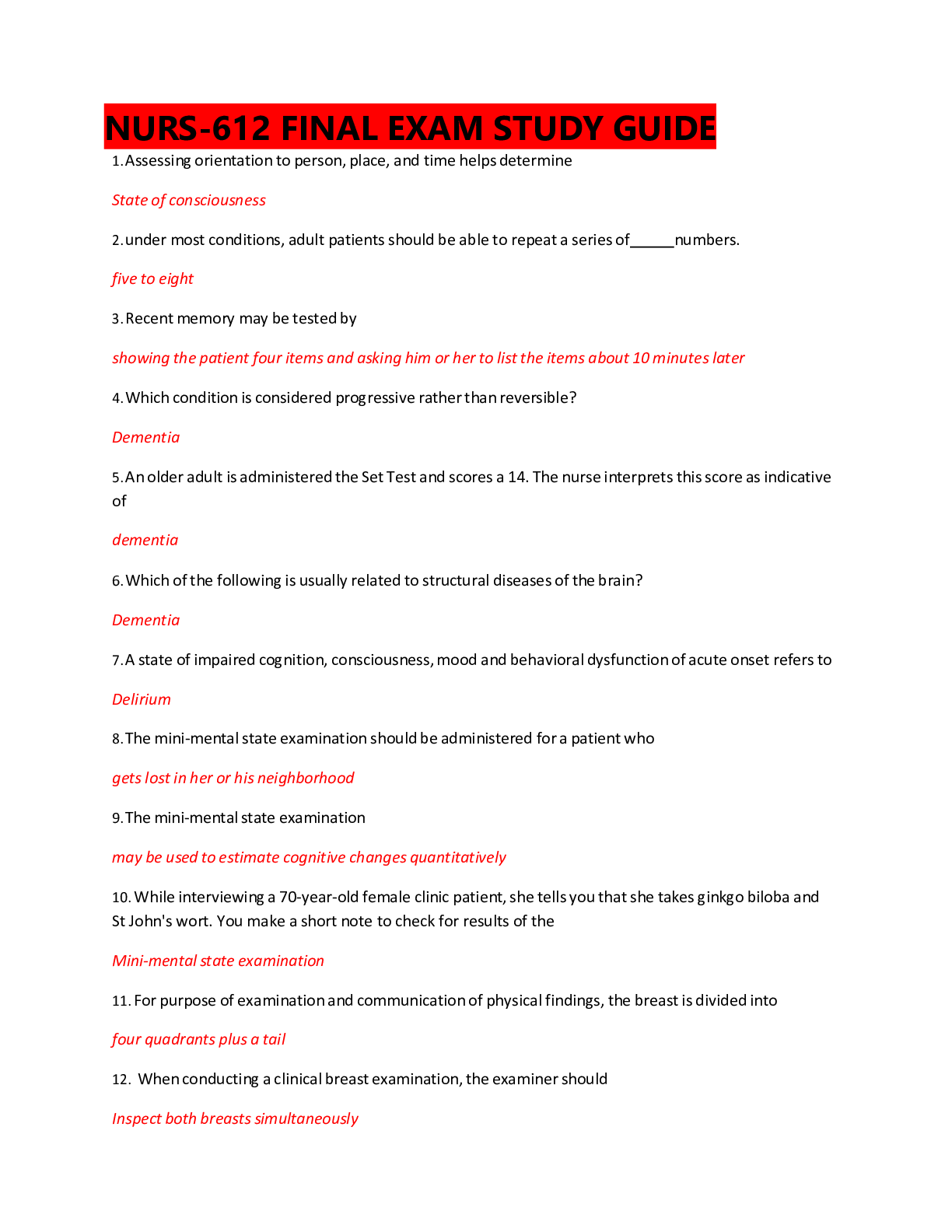
 BMAL 590- QUANTITATIVE RESEARCH TECHNIQUES AND STATISTICS TEST WITH SUMMARIZED STUDY GUIDE.png)
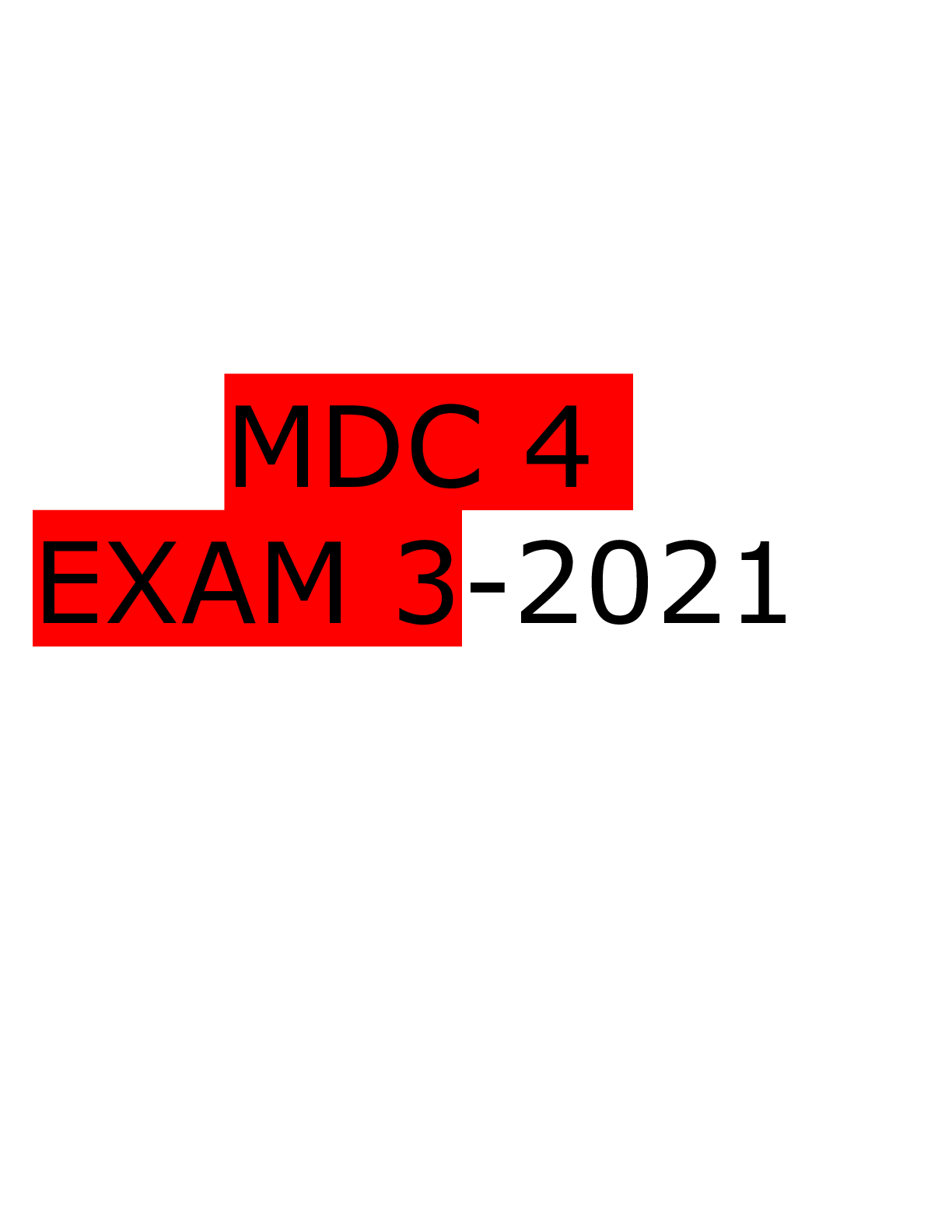
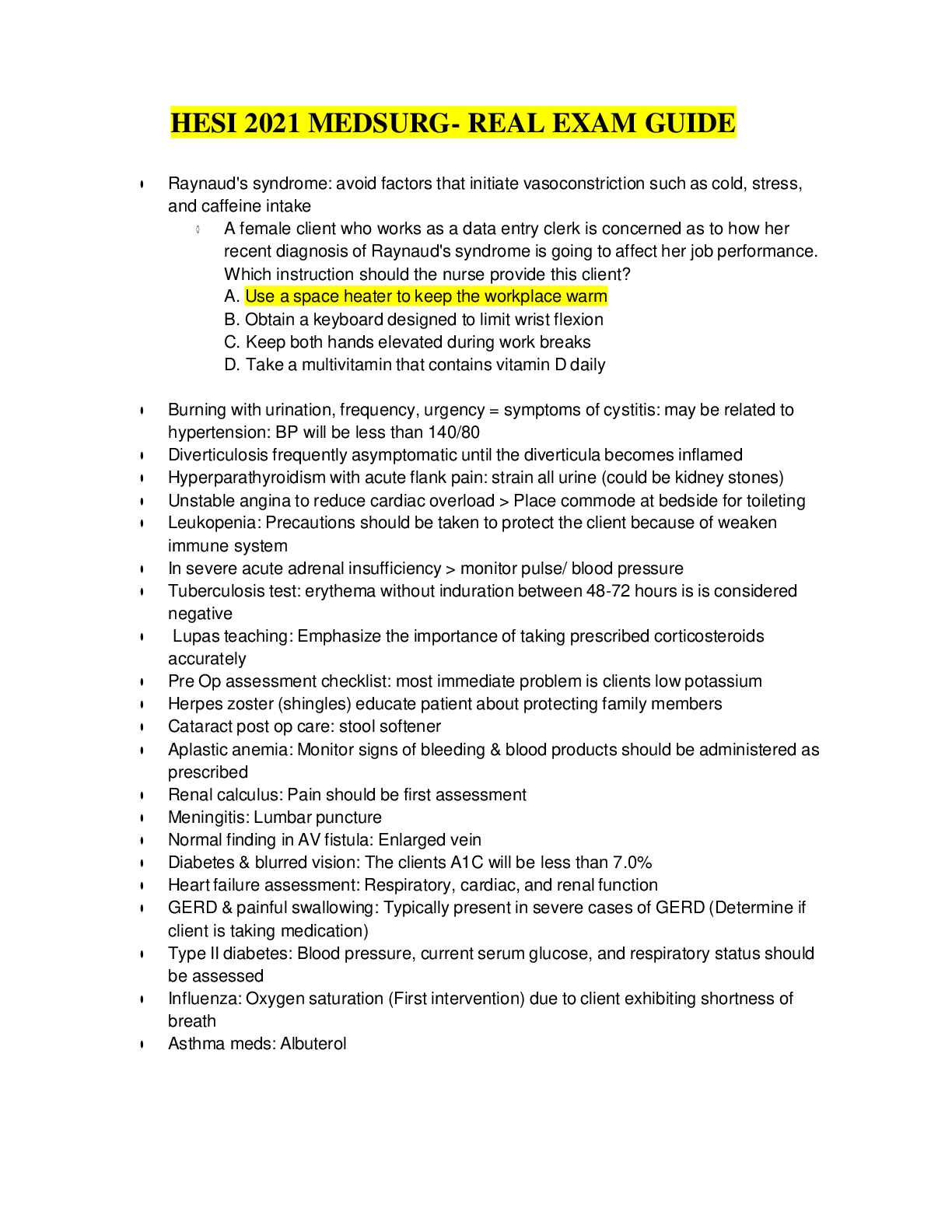









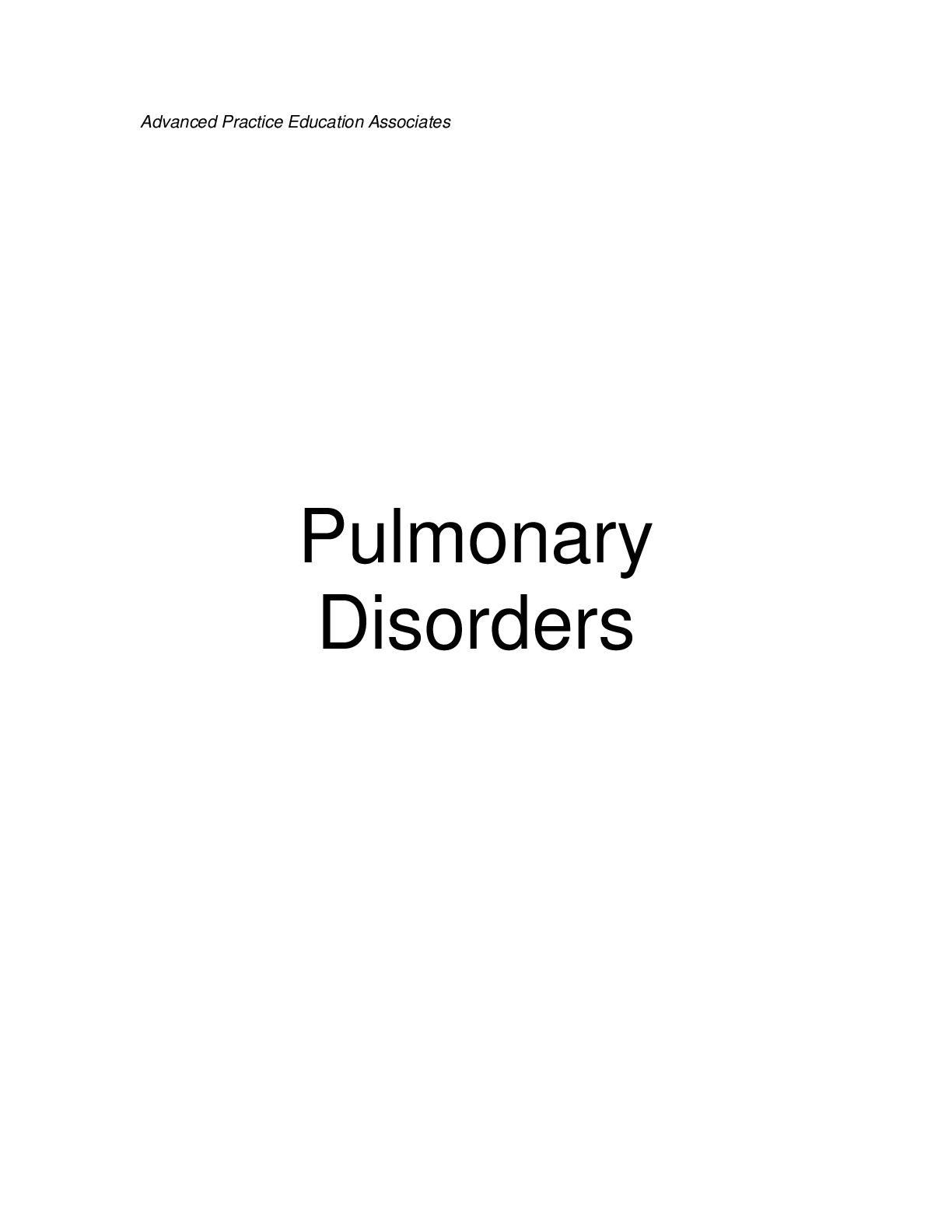
.png)





